FLUXNET (www.fluxnet.org) is a global research community measuring ecosystem scale carbon sequestration, water use and energy flows. It includes 15 large regional networks representing over a thousand research sites and thousands of scientists distributed around the world, an internationally renowned training course, FluxCourse, and the global Early Career Scientist Network. This project, funded through the NSF AccelNet program, serves to coordinate FLUXNET activities and help build the next generation of FLUXNET science.
In this project we aim to help build FLUXNET (shown on the right) into a next-generation network-of-networks. We particularly support early career researchers through an integrated set of activities, including a program of research experiences at foreign host institutions; through an internationally renowned summer school, FluxCourse and through collaborative activities with the 400+ members of the FLUXNET Early Career Scientist Network. Our group coordinates these activities though the FLUXNET Community Council Chair (Keenan) and Project Coordinator (Delwiche). We are very excited to help build the next generation of FLUXNET.
PI: KeenanCo-Is: Novick (U Indiana), Moore (U. Arizona)
Funding: National Science Foundation
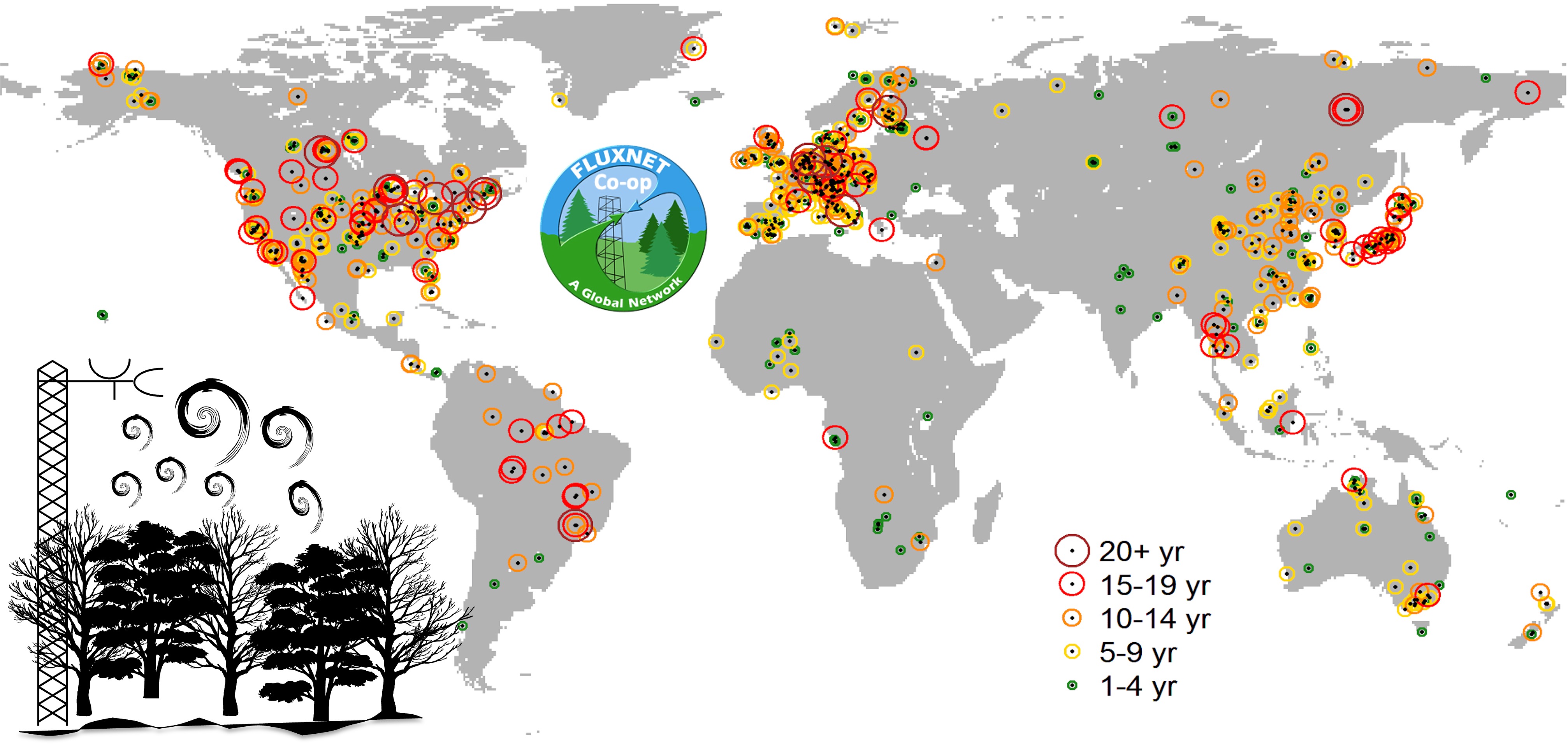
This project quantifies aboveground biomass and its uncertainty from space by leveraging NASA’s Global Ecosystem Dynamics Investigation (GEDI) waveform lidar. We use GEDI’s billions of footprints to characterize the global distribution of tree height and vertical structure, and fuse these observations with ecological theory and scalable modeling to produce robust, policy-relevant biomass estimates across biomes.
Our approach integrates GEDI waveform metrics with auxiliary remote sensing and environmental covariates to map biomass continuously, reconcile scale differences between footprint and wall-to-wall products, and propagate uncertainties. We evaluate performance across climate gradients, disturbance histories, and forest types to improve estimates of carbon stocks, change, and risk. Applications include national greenhouse-gas inventories, MRV for nature-based climate solutions, biodiversity and habitat assessments, and climate-risk analyses involving drought and fire.
PI: KeenanFunding: NASA GEDI Science Team
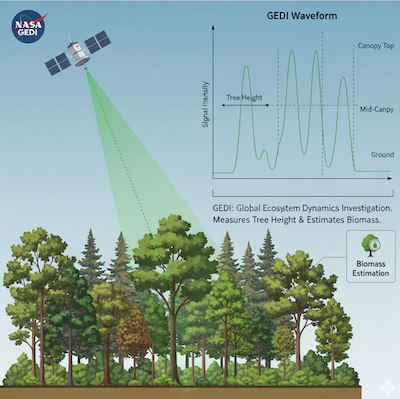
Rising CO2 has a large impact on ecosystem productivity and water use worldwide, but the magnitude and spatial variability of the response of ecosystems is poorly understood. This project leverages observations from multiple NASA missions to better understand the role of CO2 in global ecosystem carbon accumulation and related carbon-climate feedbacks.
The overarching science objective of this project is to leverage remote sensing observations from multiple NASA platforms in combination with observations in land, atmosphere and other space- based programs to quantify the effect of CO2 on the temporal and spatial variability of the uptake of carbon dioxide by the terrestrial biosphere. In addition to NASA observations, terrestrial biosphere models, tree ring isotopes, and eddy-covariance observations provide a wealth of information to constrain the historic response of photosynthesis and ecosystem carbon sequestration to rising CO2. We aim to examine increased land carbon uptake in recent decades, expected future responses of land carbon sequestration to ongoing atmospheric changes, and the likely impact of natural climate solutions given the dynamic baseline of continued climate change and land use.
PI: KeenanCo-Is: W-K Smith (U. Arizona)
Funding: NASA Carbon Cycle Science Team
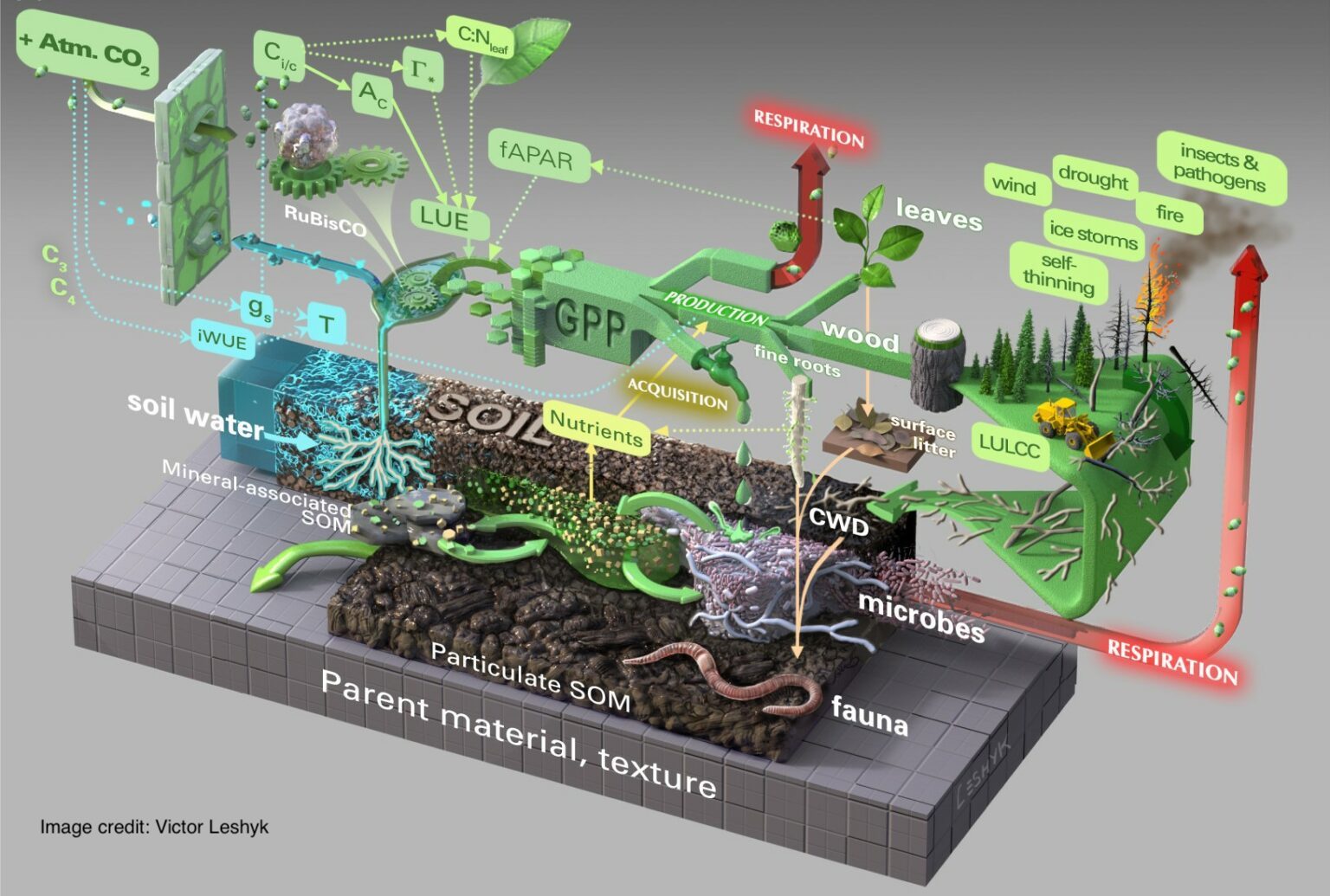
Extreme events such as drought, heatwaves and wildfire are becoming increasingly prevalent in the eastern US and will likely continue to be over the rest of this century. The HELIOS project focuses on understanding the impact of such extremes on both coastal ecosystems and water resources.
Ecosystem water use plays a large role in determining surface water availability, and thus streamflow, and societies water resources. Water use and streamflow are highly sensitive to multiple climate extremes, which frequently lead to devastating impacts on natural ecosystems and human society. For instance, co-occurrence of extreme precipitation and wind can result in massive infrastructural damage. Combined drought and heat can lead to widespread forest mortality, and extreme wildfire, as recently experienced along the US west coast. In this project we examine ecological responses to compound and sequential extreme events, and the resulting impact on coastal water resources, both in recent decades and over the coming century.
PI: KeenanFunding: DOE Early Career Award
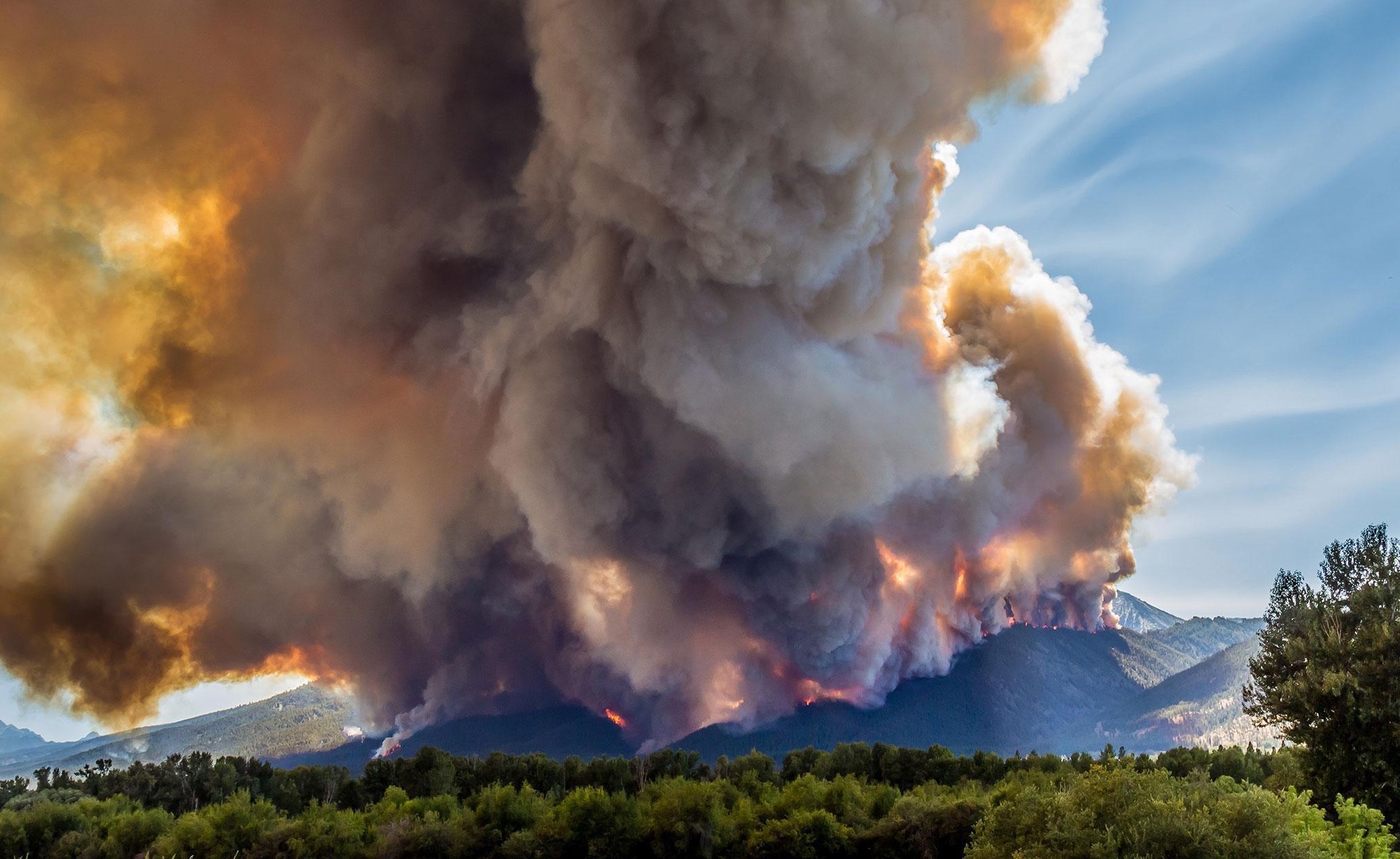
Water availability plays a large role in the global carbon, water and energy cycles, and limits ecosystem productivity in almost all biomes. The SMAP project leverages information from NASAs soil moisture active-passive (SMAP) sensor within a model benchmarking framework, combining both the carbon and water cycles to quantify the role of water in regulating global ecosystem state and function.
Limits on ecosystem productivity due to water availability manifest through constraints on the amount of biomass that can be sustained, and on the amount of photosynthesis that can be maintained. These constraints are most evident in the world’s warm and arid environments, where water plays the dominant role in primary production and where foliage cover, plant water use, and photosynthesis are all tightly coupled. They are also evident in the world’s cold regions, however, where freeze-thaw states dictate landscape hydrology and water availability. The consequences of changes in water availability on global ecosystems are thus potentially dramatic. Understanding both the current constraint of water availability on ecosystem function, and the consequences of likely future changes, is therefore an urgent need - one that we aim to address.
PI: KeenanFunding: NASA SMAP Science Team
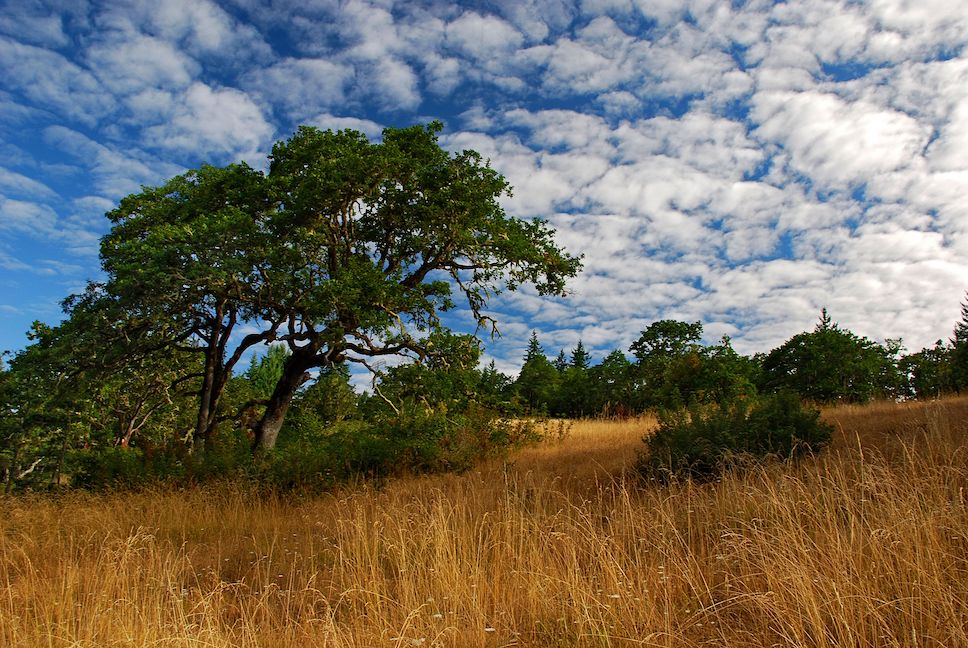
LEMONTREE will develop a next-generation model of the terrestrial biosphere and its interactions with the carbon cycle, water cycle and climate.
The LEMONTREE approach draws on eco-evolutionary optimality theory as a basis for building ecosystem models that rest on firm theoretical and empirical foundations, and that can be incorporated into the land-surface component of climate models. These models should eventually yield more reliable projections of future climates. This could give a newfound ability to address issues in sustainability, including the potential to maintain the biosphere’s capacity to regulate the carbon cycle while benefiting human well-being and development. LEMONTREE is an international consortium with participants from UC Berkeley, The University of Reading, Imperial College London, Columbia University, the University of Pittsburgh, Utrecht University, Seoul National University, Texas Tech University, Tsinghua University and the Swiss Federal Institute of Technology in Zurich.
PI: Harrison, U. Reading UKCo-Is: Keenan, Prentice, N. Smith, Ryu, W. Han, Gentine, Stocker, Liang, Vidale, Graven, Rebel, De Boer
Funding: Schmidt Foundation VESRI
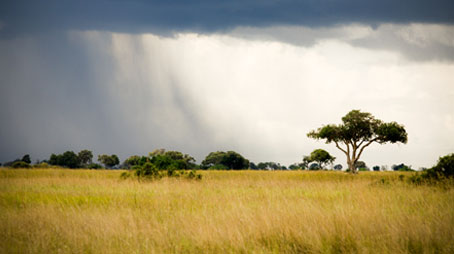
Flash droughts are typically distinguished from conventional droughts on the basis of their rapid onset and/or duration. This project aims to examine the role of vegetation in flash drought events.
Flash droughts come on seemingly without warning, and sometimes with devastating effects. Another distinguishing feature of flash droughts is that they are largely driven by evaporative demand. This has implications for the dynamics and predictability of flash droughts in a changing climate. It also suggests that understanding and prediction of flash droughts is inherently linked to understanding and prediction of high evaporative demand periods, including heat extremes that persist for several days to weeks. In this NSF PREEVENTS project, we are working to advance the understanding and subseasonal-to-seasonal prediction of flash droughts and their associated heat extremes. At Berkeley, we are developing machine-learning based estimates of photosynthesis, evapotranspiration and respiration at high resolution, in combination with remotely sensed estimates of evaporative stress, to define and characterize flash drought events.
PI: Zaitchik (Johns Hopkins)Co-Is: Keenan, Badr (Johns Hopkins), Otkin (U. Wisconsin-Madison), Anderson (USDA)
Funding: NSF PREEVENTS
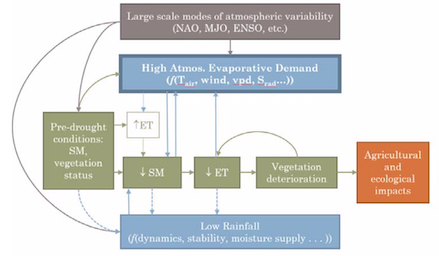
The overarching objective of this interdisciplinary project is to improve understanding of the global exchange of carbon between terrestrial ecosystems and the atmosphere, by leverage new theory and observations in land, atmospheric and space-based research at high spatial and temporal resolutions.
We use eddy-covariance observations together with a suite of NASA, DOE and other partner agency data, to improve estimates of the partitioning of carbon between the biosphere and the atmosphere, advance theory on ecosystem scale photosynthetic light- and water-use efficiency, and develop a high-resolution framework that uses machine learning to combine these advances. By bringing together the "bottom up" and the "top down," we aim to elucidate the controls of inter-annual variability and transform our ability to characterize carbon-climate feedbacks. This will improve insight into the processes that govern global carbon uptake and functional responses that control the magnitude of carbon cycle feedbacks, a key goal in order to improve our ability to predict the future evolution of the Earth System.
See resulting publications here.
PI: KeenanCo-Is: Fisher (JPL), Michalak (Stanford)
Funding: NASA Interdisciplinary Science
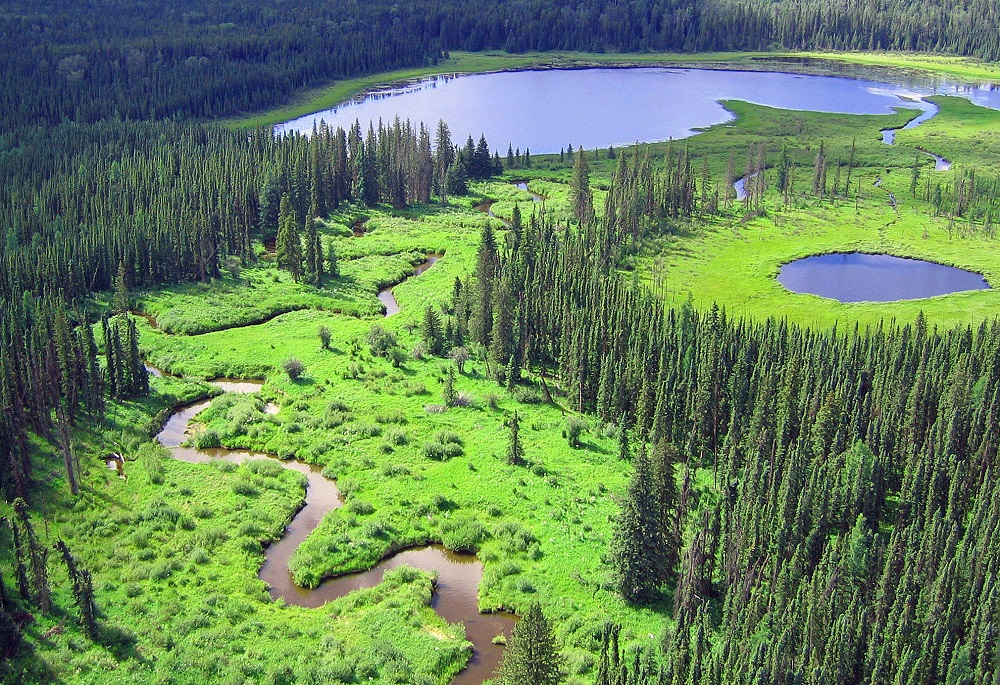
Plants adapt and have the potential to acclimate, through changes in resource allocation, to the environment. This project aims to develop a theory of photosynthetic acclimation from first principles.
Under this project we are developing photosynthetic theory and using it to generate and test hypotheses regarding the mechanisms governing the biotic control of photosynthesis in response to climate. We combine recent understanding of optimal resource allocation with a large global databases of physiological measurements. Our results suggest that plants acclimate to growth conditions in a manner that fulfills co-optimality criteria. The resulting hypotheses regarding acclimation responses have large implications for the response of vegetation, and thus the global carbon cycle, to ongoing climate change.
See resulting publications here.
PI: KeenanFunding: DOE LDRD

